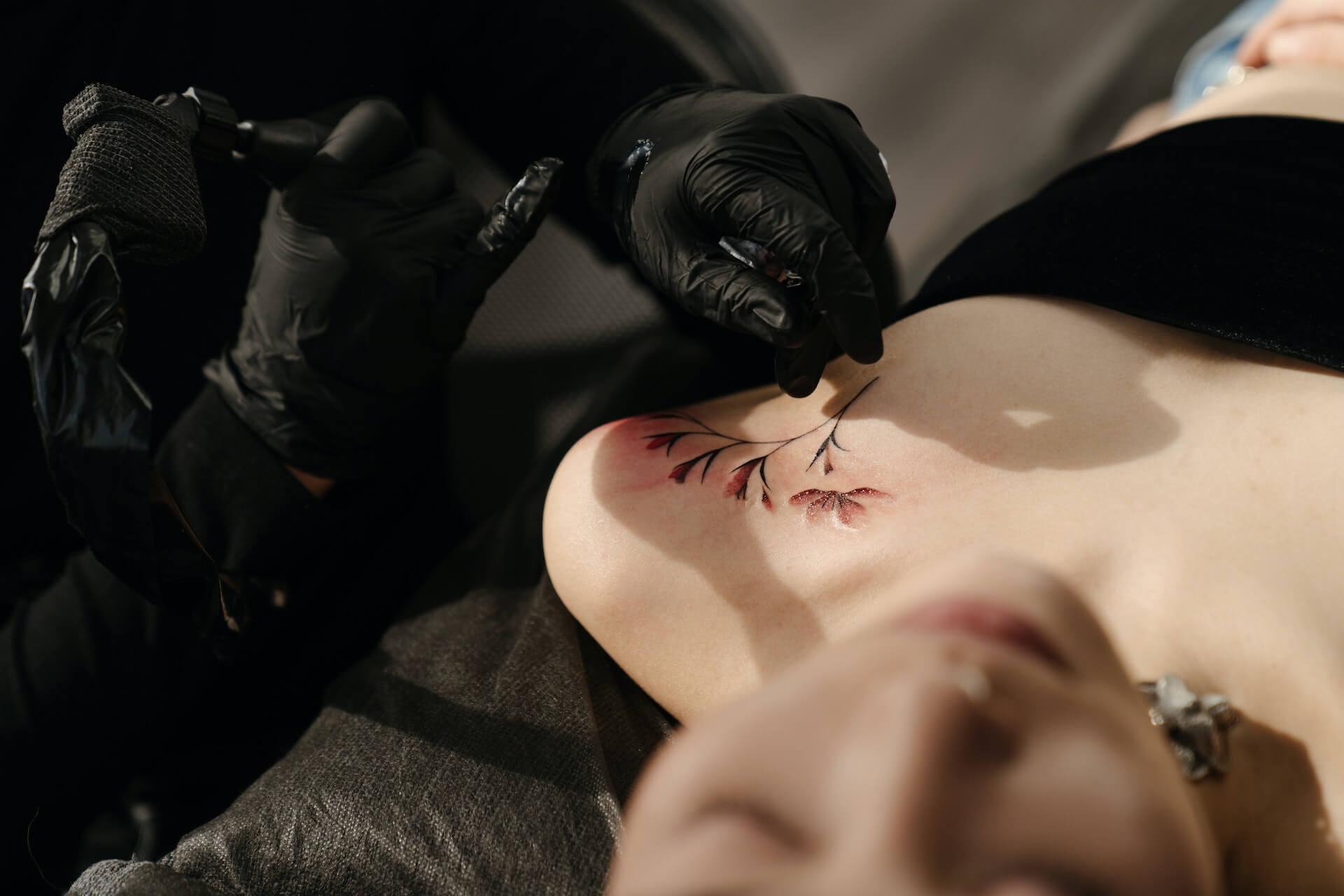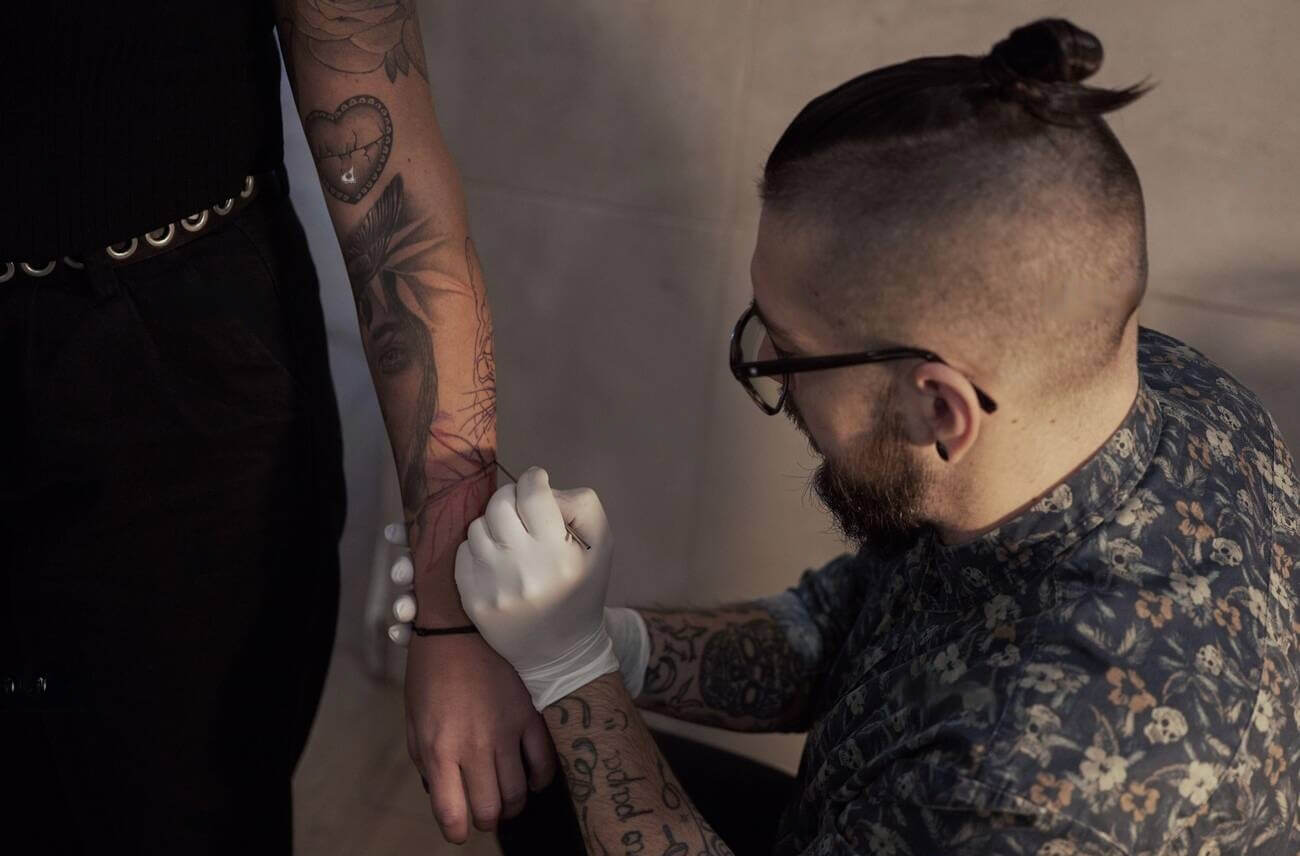Contents
show
Freehand tattooing is a unique and personal form of tattoo art that allows for complete creative expression and customization. In this guide, we will explore the benefits of freehand tattooing, the differences between freehand and stencil tattooing, and tips for successful freehand tattooing.
 A Freehand Tattoo is a type of tattoo art where the artist draws the design directly onto the skin without the use of stencils or pre-drawn patterns. This allows for greater creative freedom and customization, resulting in unique and personal tattoos. The process of freehand tattooing requires a higher level of artistic skill compared to traditional stencil-based methods and often results in a more fluid and natural-looking design.
Unlike traditional tattooing methods that rely on stencils and pre-drawn designs, freehand tattooing gives artists the freedom to draw their designs directly onto the skin. This not only results in a unique and one-of-a-kind piece, but also allows for greater artistic collaboration between the artist and the client.
The steps of freehand tattooing process:
A Freehand Tattoo is a type of tattoo art where the artist draws the design directly onto the skin without the use of stencils or pre-drawn patterns. This allows for greater creative freedom and customization, resulting in unique and personal tattoos. The process of freehand tattooing requires a higher level of artistic skill compared to traditional stencil-based methods and often results in a more fluid and natural-looking design.
Unlike traditional tattooing methods that rely on stencils and pre-drawn designs, freehand tattooing gives artists the freedom to draw their designs directly onto the skin. This not only results in a unique and one-of-a-kind piece, but also allows for greater artistic collaboration between the artist and the client.
The steps of freehand tattooing process:

What is a Freehand Tattoo?

- Consultation and Agreement: The tattoo artist and client discuss and agree on a design sketch.
- Sketching on Skin: The artist uses medical markers with skin-safe ink to draw the sketch onto the client’s skin, outlining the main elements and images.
- Tattooing: Following the pre-marked outline, the artist starts the actual tattooing process.
The Benefits of Freehand Tattooing

- Personalization: With freehand tattooing, artists can create custom designs specifically tailored to their clients’ desires and personal styles. This results in tattoos that are unique and personal to each individual.
- Creative Freedom: Freehand tattooing offers greater creative freedom for the artist compared to stencil-based methods. Artists can easily make adjustments to the design on the fly and can even incorporate elements of the client’s body into the design.
- Improved Bond between Artist and Client: Freehand tattooing allows for greater collaboration between the artist and the client. The process of drawing the design directly onto the skin fosters a deeper connection and mutual understanding between the two parties.
- Better Integration with the Body: The usual transfer of a sketch using transfer paper does not allow you to take into account all the features of anatomy, especially if it is convex in shape or moving part of the body. In this case, the freehand method allows the artist to immediately make a three-dimensional sketch and see how the drawing will look in person. Thus, freehand designs are often more fluid and natural-looking as they are drawn directly onto the skin, allowing for a better integration with the body’s curves and contours.
- Unique Design: With freehand tattooing, the design is not limited by pre-existing patterns or stencils, resulting in truly unique and one-of-a-kind tattoos.
- Higher level of Artistic Skill: Freehand tattooing requires a higher level of artistic skill and mastery compared to stencil-based methods, resulting in a more impressive final product.
Freehand VS Stencil Tattooing
- Design Process: The most notable difference between freehand and stencil tattooing is the design process. In freehand tattooing, the artist draws the design directly onto the skin, while in stencil tattooing, a pre-drawn stencil is used as a template for the tattoo.
- Customization: Freehand tattooing allows for greater customization, as the artist can make changes to the design on the fly, while stencil tattooing is limited to the pre-existing design.
- Artistic Freedom: Freehand tattooing offers greater artistic freedom compared to stencil tattooing. The artist can draw freely without being limited by pre-existing stencils or patterns.
- Skill Level: Freehand tattooing requires a higher level of artistic skill compared to stencil tattooing. The artist must be able to draw the design directly onto the skin without the assistance of a stencil.
- Unique Design: Freehand tattoos are often more unique and personal compared to stencil tattoos, as the design is not limited by pre-existing patterns.
- Integration with the Body: Freehand tattoos are often more fluid and natural-looking as they are drawn directly onto the skin, allowing for a better integration with the body’s curves and contours. In contrast, stencil tattoos can sometimes appear flat or rigid as they follow the template of the stencil.
How to Tattoo Successful Freehand?
Freehand tattooing requires a higher level of artistic skill and mastery so let’s explore tips and techniques for successful freehand tattooing.- Practice Your Drawing Skills: To become a successful freehand tattoo artist, it’s essential to have a strong foundation in drawing. Whether you prefer to work in traditional mediums like pencil and paper or digital tools like Procreate or Adobe Illustrator, it’s important to continually practice your skills and hone your craft.
- Study the Human Body: Understanding the anatomy and structure of the human body is crucial for freehand tattooing. Study how muscles, bones, and skin interact with each other and how to create designs that integrate with the body’s curves and contours.
- Communicate with Your Client: Communication is key when it comes to freehand tattooing. Before you start your design, make sure to have an open and honest conversation with your client about their vision and preferences. This not only helps you create a design that they will love, but it also fosters a deeper connection between you and your client.
- Start with Simple Designs: When you’re first starting out with freehand tattooing, it’s best to begin with simple designs that allow you to practice your skills and build confidence. As you become more comfortable with the process, you can gradually work your way up to more complex designs.
- Keep Your Hands Steady: A steady hand is crucial when it comes to freehand tattooing. Make sure to maintain good posture and control your breathing to keep your hand as steady as possible. You can also invest in a high-quality, ergonomic tattoo machine to help reduce hand fatigue and improve your accuracy.
- Experiment with Different Tools: There are a variety of tools available for freehand tattooing, from traditional tattoo machines to markers and paintbrushes. Experiment with different tools to find what works best for you and your style.
- Take Your Time: Freehand tattooing requires patience and precision. Don’t rush the process, take your time and make sure to double-check your design before you start tattooing. This will help ensure that you create a clean, precise final product.
- Ask for Feedback: Don’t be afraid to ask for feedback from other tattoo artists or clients. This not only helps you improve your skills, but it also shows that you are dedicated to your craft and take your work seriously.
- Keep Learning: The world of freehand tattooing is constantly evolving, and it’s important to stay up-to-date with the latest techniques and trends. Attend workshops and conventions, watch tutorials, and keep practicing your skills to continue growing as an artist.
Freehand Tattoo Artists
The Future of Freehand Tattooing: Analysis and Predictions
There are several things that affect the future greater value and relevance of freehand tattoos than a stencil. First, there are technological advances. Technology is always changing and improving, and it’s likely that this trend will continue in the tattoo industry. As new tools and techniques become available, freehand artists may be able to push the limits of what is possible with this method and create even more impressive designs. The second is the increased demand for uniqueness. The client wants to be different and doesn’t want to get a tattoo the same as a dozen other people. Moreover, the sophistication and demandingness of customers is also increasing. From here appears necessity for tattoo master to develop and unique his skill, to work out own style. This also means a higher demand for unique freehand tattoos. With its ability to create truly unique and personalized designs, more people are likely to seek out freehand artists for their next tattoo. So if you are a beginner tattoo artist, we recommend you to study carefully human anatomy and develop your drawing skills. This will allow you in the future, with practice, to learn how to work in the actual style, without stencils and extremely accurate sketches.
FAQ
When is it better to use stencil paper instead of freehand?
Stencil paper may be preferred over freehand in the following cases: Complex designs:
- Complex designs: When the design is highly intricate or detailed, using a stencil paper can ensure accuracy and consistency.
- Time efficiency: Using a stencil paper can save time compared to freehand, as it eliminates the need for the artist to draw the design directly on the skin.
- Symmetry and straight lines: If the design requires perfect symmetry or straight lines, stencil paper can provide a more precise outline compared to freehand.
- Cover-ups: When covering up an existing tattoo, a stencil paper can help the artist accurately place the new design over the old one.
- Nervous clients: Some clients may feel more comfortable with a stencil paper as it offers a clear preview of the final design and reduces the uncertainty of the freehand approach.
- Portraits: When tattooing a portrait of a person, stencil paper may be preferred as it allows the artist to accurately capture the likeness and features of the subject.
Tattoo artists use what kind of freehand tattoo markers?
Freehand tattoo markers are specially designed markers used by tattoo artists to sketch or outline a design on the skin before starting the tattooing process. These markers use skin-safe ink that is easy to remove and will not interfere with the final tattoo. Some commonly used freehand tattoo markers include:
- Thermal Transfer Pen: This pen uses heat to transfer ink onto the skin, creating a semi-permanent outline that can be easily removed with soap and water.
- Skin Marker Pen: This type of pen uses a water-soluble ink that is safe for the skin and can be easily removed with soap and water.
- Chalk Pen: Chalk pens use a white, powdery ink that is easy to remove and does not smudge or smear.

